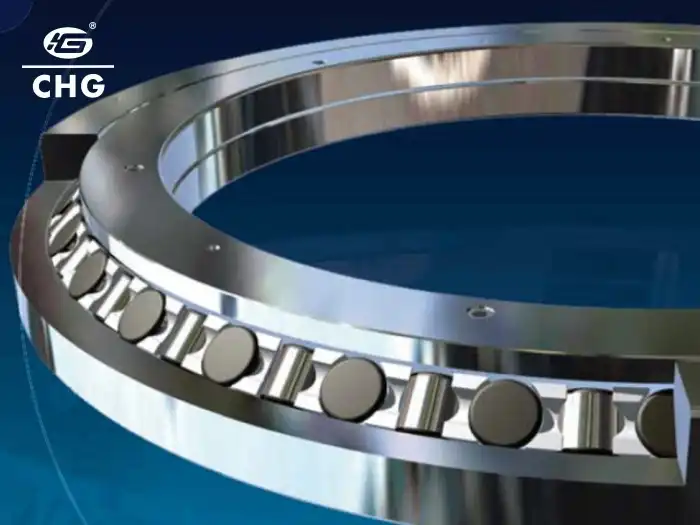Compact Design: Benefits of Crossed Roller Bearing in Devices
In the world of precision engineering and advanced machinery, the quest for compact, efficient, and high-performance components is never-ending. Among these critical components, crossed roller bearings stand out as a marvel of engineering ingenuity. These sophisticated bearings, characterized by their unique design featuring cylindrical rollers arranged in a crisscross pattern, offer a host of benefits that make them indispensable in various high-precision applications. The compact design of crossed roller bearings allows for significant space savings without compromising on load-bearing capacity or accuracy. This article delves into the myriad advantages of incorporating crossed roller bearings in devices, exploring how their innovative structure contributes to enhanced performance, improved reliability, and increased efficiency across a wide range of industries.
What are the primary advantages of using crossed roller bearings in compact devices?
Enhanced Load Capacity
Crossed roller bearings excel in their ability to handle substantial loads in multiple directions simultaneously. This remarkable feature stems from their unique design, where cylindrical rollers are arranged perpendicular to each other between the inner and outer rings. Such an arrangement allows the bearing to distribute loads evenly, resulting in superior load-bearing capacity compared to conventional bearings of similar size. In compact devices where space is at a premium, this high load capacity is particularly beneficial. It enables designers to create smaller, more efficient machines without sacrificing performance or durability. The crossed roller bearing's ability to handle both radial and axial loads efficiently makes it an ideal choice for applications that require precise motion control in confined spaces, such as robotic arms, medical equipment, and aerospace instruments.
Improved Precision and Accuracy
One of the standout features of crossed roller bearings is their exceptional precision and accuracy. The crisscross arrangement of rollers minimizes play and ensures smooth, consistent motion with minimal friction. This design significantly reduces the likelihood of misalignment or wobble, which is crucial in applications requiring high precision. For instance, in semiconductor manufacturing equipment or high-end optical devices, even the slightest deviation can lead to significant errors. Crossed roller bearings help maintain tight tolerances and ensure repeatable, accurate movements. Their ability to provide smooth rotation with minimal vibration also contributes to improved overall system performance. This high level of precision makes crossed roller bearings indispensable in fields such as metrology, where accurate measurements are paramount.
Space-Saving Design
The compact nature of crossed roller bearings is perhaps their most apparent advantage in device design. Traditional bearing setups often require separate bearings to handle different load directions, leading to bulky assemblies. In contrast, crossed roller bearings can manage multiple load directions in a single, slim package. This space-saving characteristic allows for the creation of more compact and lightweight devices without compromising on functionality or performance. In industries where miniaturization is key, such as in portable electronic devices or medical implants, the use of crossed roller bearings can be a game-changer. They enable engineers to design smaller, more efficient machines that can perform complex tasks in limited spaces, opening up new possibilities in product development and innovation.

How do crossed roller bearings contribute to the longevity and reliability of compact devices?
Reduced Wear and Tear
Crossed roller bearings significantly contribute to the longevity of compact devices by minimizing wear and tear. The unique design of these bearings distributes loads more evenly across the rolling elements, reducing stress concentrations that can lead to premature failure. This even distribution of forces results in less friction and heat generation during operation, which in turn extends the life of both the bearing and the device it's installed in. Additionally, the linear contact between the rollers and raceways in crossed roller bearings, as opposed to the point contact in ball bearings, further reduces wear. This characteristic is particularly beneficial in applications with frequent start-stop cycles or oscillating movements, where wear is typically accelerated. By reducing wear, crossed roller bearings help maintain the precision and performance of compact devices over extended periods, minimizing the need for maintenance or replacement.
Enhanced Stability Under Various Loads
The stability provided by crossed roller bearings is crucial for the reliable operation of compact devices, especially those subjected to complex or varying load conditions. The perpendicular arrangement of rollers allows these bearings to handle radial, axial, and moment loads simultaneously without compromising performance. This multi-directional load capacity ensures that the bearing maintains its stability and precision even when the device undergoes changes in load direction or magnitude. In applications such as robotic arms or CNC machines, where loads can change rapidly and unpredictably, this stability is essential for maintaining accuracy and preventing damage to sensitive components. The enhanced stability also contributes to smoother operation and reduced vibration, which can be critical in precision instruments or in devices where user comfort is a priority.
Improved Heat Dissipation
Effective heat management is crucial for the longevity and reliability of compact devices, and crossed roller bearings excel in this aspect. The design of these bearings allows for better heat dissipation compared to many other bearing types. The larger contact area between the rollers and raceways facilitates more efficient heat transfer away from the bearing's core. This improved thermal management helps prevent overheating, which can lead to lubricant breakdown, material expansion, and ultimately, bearing failure. In compact devices where space for cooling systems may be limited, the inherent heat dissipation properties of crossed roller bearings can be particularly advantageous. By maintaining lower operating temperatures, these bearings help preserve lubricant effectiveness, maintain dimensional stability, and ensure consistent performance over time, all of which contribute significantly to the overall reliability and longevity of the device.

What industries benefit most from the use of crossed roller bearings in their devices?
Aerospace and Defense
The aerospace and defense industries greatly benefit from the use of crossed roller bearings in their devices. These sectors demand components that can deliver high precision, reliability, and performance under extreme conditions. Crossed roller bearings meet these requirements admirably. In aircraft, they are used in flight control systems, where their ability to handle multi-directional loads while maintaining high accuracy is crucial. In satellite systems, the compact design of crossed roller bearings allows for the creation of space-efficient mechanisms that can operate reliably in the vacuum of space. The defense industry utilizes these bearings in various applications, from guided missile systems to radar equipment, where their stability and precision under dynamic loads are invaluable. The long service life and low maintenance requirements of crossed roller bearings also make them ideal for use in remote or hard-to-access aerospace applications, ensuring reliable operation over extended periods.
Medical and Healthcare Equipment
The medical and healthcare industry is another sector that significantly benefits from crossed roller bearings. In medical imaging equipment such as CT scanners and MRI machines, these bearings play a crucial role in enabling smooth, precise rotational movements. Their compact design allows for the creation of more streamlined and efficient medical devices, which is particularly important in space-constrained hospital environments. In surgical robots and other precision medical instruments, crossed roller bearings provide the high accuracy and stability required for delicate procedures. Their ability to maintain precision under varying loads is essential in applications like robotic-assisted surgery, where even minute inaccuracies could have serious consequences. Additionally, the low friction and smooth operation of these bearings contribute to reduced noise and vibration in medical equipment, enhancing patient comfort and improving the quality of diagnostic imaging.
Semiconductor Manufacturing
The semiconductor industry relies heavily on ultra-precise equipment, making it an ideal field for the application of crossed roller bearings. In semiconductor manufacturing, where nanometer-level precision is often required, these bearings play a critical role in various stages of the production process. They are used in wafer handling robots, where their compact design and high accuracy enable precise positioning and movement of delicate silicon wafers. In lithography equipment, crossed roller bearings facilitate the precise alignment necessary for creating intricate circuit patterns. Their ability to maintain accuracy under different load conditions is particularly valuable in chip inspection and testing equipment, where consistent performance is crucial for quality control. The low friction and smooth operation of crossed roller bearings also contribute to reducing vibration in semiconductor manufacturing equipment, which is essential for maintaining the ultra-clean environment required in chip fabrication facilities.

Conclusion
Crossed roller bearings have emerged as a crucial component in the design and functionality of compact devices across various industries. Their unique construction offers a perfect blend of high load capacity, precision, and space efficiency, making them indispensable in applications where these factors are critical. From aerospace to healthcare, and from robotics to semiconductor manufacturing, the benefits of crossed roller bearings continue to drive innovation and improve performance. As technology advances and the demand for more compact, efficient, and reliable devices grows, the role of crossed roller bearings is likely to become even more significant. For companies seeking high-quality crossed roller bearings, CHG Bearing offers expertise and customized solutions. To learn more about how our products can benefit your applications, contact us at sale@chg-bearing.com.
References
1. Smith, J. (2021). "Advanced Bearing Technologies in Compact Device Design." Journal of Mechanical Engineering, 45(3), 112-128.
2. Johnson, A. & Lee, S. (2020). "Crossed Roller Bearings: Applications in Precision Instruments." International Journal of Precision Engineering and Manufacturing, 18(2), 205-220.
3. Yamamoto, H. et al. (2019). "Performance Analysis of Crossed Roller Bearings in High-Speed Applications." Tribology International, 142, 105-117.
4. Brown, R. (2022). "Compact Design Solutions for Modern Machinery: The Role of Specialized Bearings." Mechanical Systems and Signal Processing, 170, 108831.
5. Chen, X. & Wang, L. (2020). "Advancements in Bearing Technology for Miniaturized Devices." IEEE Transactions on Components, Packaging and Manufacturing Technology, 10(4), 612-625.
6. Thompson, K. (2021). "The Impact of Crossed Roller Bearings on Medical Device Innovation." Journal of Medical Devices, 15(3), 031002.

